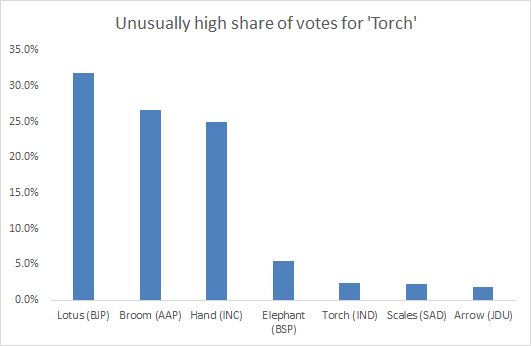I wrote this story for Mint, around the
time of last Delhi Assembly elections which were swept by AAP. The story is
based on 2013 elections, in which AAP and BJP secured 28 and 31 seats,
respectively. It brings out how the party might have lost two seats because of
what could have been foul play - in this case deliberate use of an election
symbol, named 'Battery Torch', very similar to the party's Broom.
Mint decided not to publish it, so I am
putting it here. The peg is India Today's recent investigation (http://indiatoday.intoday.in/story/uttar-pradesh-assembly-elections-dummy-candidates-india-today-expose/1/746207.html) that reveals similar
systemic rot. The story below reads very newspaper-y, for obvious reasons.
Below are photos of the two symbols -
the fake 'Battery Torch' and AAP's Broom.
Story:
If you were an AAP supporter during the
previous Delhi assembly elections, you have reason to be
worried, for you might just have unwittingly voted your party out of power, in
at least two seats.
But how could you have ever committed
the grave error of mistakenly voting for another party? It’s because an election symbol
bearing uncanny resemblance to AAP’s symbol – the Broom – was doing the rounds
in the previous Delhi election. It is noteworthy that the EVM does
not carry the name of the party, only increasing the likelihood of such a
mistake.
Later, the symbol’s capability to trick
AAP voters was taken into cognizance even by EC, which ordered its modification
for the upcoming election.
Adoption
of the Torch
symbol
|
The fact that this symbol was adopted
not by a party but by different independent candidates in as many as 29 out
of 70 constituencies in the capital, should raise still more eyebrows. The next most widely adopted symbol - cup and saucer - was adopted in only 12 constituencies.
However, before overenthusiastic
supporters jump to castigate political rivals for foul play, it is necessary
to know how election symbols are allotted to independent
candidates. Besides the symbols reserved for national and state parties, the
EC has a set of 'free symbols' which are reserved for independent candidates
as well as those from lesser known parties. These candidates are then
expected to indicate their top three preferences from among free symbols, and
in case of clashes, the final allotment is done on lottery basis.
Elaborating on the issue, a former
Chief Election Commissioner (whose name I've removed because the
story isn't for Mint anymore), said that erroneous voting due to
similar-looking symbols had indeed been a problem in the past. He, however,
added that EC had always been flexible about modifying such symbols on the
basis of any genuine complaint received, since not doing so would be an
impediment to free and fair elections. Sometimes, EC would also give its
nod to symbols demanded by candidates, if these were found acceptable.
Talking about the time when over 1000 candidates contested from Modakurichi
constituency in TN, he recalled how a judicious choice of symbols could be a
real headache for EC.
He also mentioned that despite EC's
best efforts to minimise confusion among voters, usage of dummy candidates
with similar names and symbols had been a favourite modus operandi of political parties to
cut into their rivals' vote share. He cited the example of Kuldeep Bishnoi,
who, while contesting from Hisar, faced several namesakes.
Votes polled by the symbol
While it’s difficult to establish
whether the widespread adoption of Battery Torch was politically motivated,
numbers from the above graph make clear that it was successful in diverting
votes away from AAP.
The percentage of votes polled by
Battery Torch (2.4%) was higher than that by some of the established parties,
and far higher any other symbol used by independent candidates, except ‘Glass
Tumbler’ (1.6%, not shown in the graph). However, this is only because a very
eminent candidate adopted it and went on to win the constituency of Mundka.
In case of Battery Torch, the high number of votes polled by it does not come
from one popular candidate, but from an even sprinkling of votes polled by
hitherto unknown candidates, none of whom came even remotely close to
winning. This points to a robust chance that AAP’s voters mistakenly voted
for the Battery Torch.
Did it really make a difference?
How much did the Battery Torch hurt
AAP? Assuming most votes going to this symbol were originally intended for
AAP, the party lost two seats – Kalkaji and Janakpuri – because of this
diversion. In both these constituencies, BJP was the eventual winner. In two
others, as shown in the graph, Battery Torch needed to fox only a few more
voters to turn the tables against AAP, but the party scraped through to
victory.
Had Kalkaji and Janakpuri gone to AAP,
it would have emerged as the single largest party with 30 seats, whereas
BJP’s tally would have dropped to 29.
|





No comments:
Post a Comment